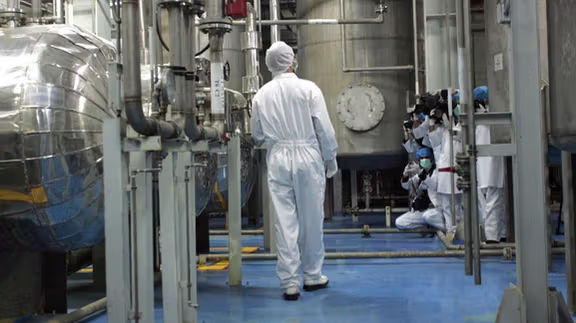US Officials: Iran Nuclear ‘Break-Out’ Under 12 Months With Restored Deal

Reviving the 2015 nuclear deal would see Iran closer than a year to holding enough fuel for a bomb, United States officials have told the Wall Street Journal.

Reviving the 2015 nuclear deal would see Iran closer than a year to holding enough fuel for a bomb, United States officials have told the Wall Street Journal.
This is a shorter time-frame than the 12-month calculation underpinning the 2015 agreement, the JCPOA (Joint Comprehensive Plan of Action), which Iran and world powers are negotiating in Vienna to restore.
The Wall Street Journal Thursday cited US officials saying they had reached this conclusion late last year but still considered the JCPOA worth reviving. ‘Break out’ is seen as the time required for the US to both detect a possible Iranian bomb program and take counter-measures.
The12-month period, while not cited in the JCPOA, was based on the amount of enriched uranium held by Iran under the agreement, and the number and nature of centrifuges – the key device – available or in use. Before the 2015 agreement, the time was under a year.
The JCPOA set limits on the amount of uranium Iran could stockpile and limited the degree of enrichment to 3.67 percent, well below the 90 percent of ‘weapons grade.’
While there would be little ambiguity over Iran returning to these limits, Iranian negotiators may be arguing in Vienna that it is impractical to limit centrifuges to the less advanced ones allowed by the JCPOA, especially as some have been reportedly destroyed by attacks on nuclear sites widely attributed to Israel.
But the biggest challenge in calculating ‘break out’ – and which may explain the latest assessment of a restored JCPOA – is factoring in the value of experience and knowledge gained by Iranian scientists in the expansion and improvement of the program since 2019, including in deploying more advanced centrifuges.
Increased knowledge and experience
“There’s nothing that a restored JCPOA will do to compensate for that increased knowledge and experience” Iran had gained, Robert Einhorn, a former senior State Department arms-control official, told the Wall Street Journal. Einhorn said a six-month break-out period would be enough time to respond—militarily if necessary—to an overt Iranian nuclear breakout.
A State Department spokesperson approached by the Wall Street Journal refused to comment on break-out assessments while insisting the US administration believed a restored JCPOA “would address our urgent nonproliferation concerns.”
The spokesman reiterated a message, delivered by among others Secretary of State Antony Blinken, that “we have only a few weeks to conclude an understanding, after which the pace of Iran’s nuclear advances will make return to the JCPOA impossible.”
While any break out would be shorter than the time Iran would need to assemble a deliverable device, some former US officials have suggested that a period of under six months would remove Washington’s ability to respond sudden ramp-up beyond the JCPOA.
Talks in Vienna over restoring the JCPOA, paused this week for political consultations, have struggled to agree how exactly the Iranian nuclear program be brought back within JCPOA limits and precisely which US sanctions violate the agreement.
Iran began exceeding the JCPOA in 2019, last year reaching 60 percent enrichment, after President Donald Trump left the agreement in 2018 and imposed ‘maximum pressure’ sanctions his officials said would lead Tehran to accept 12 US demands, including ending all enrichment, scrapping missile defense, and breaking regional alliances.